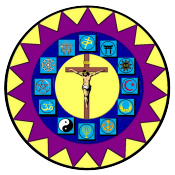Our Founder's History
Ernest Steadman the Early Years
cd
This is a photo of Ernest’s mother and father, Maude Irene Lobdell and Roy Albert Meek, taken at Alum Rock Park in San Jose California about 1946.
ba
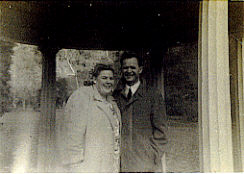
Ernest Albert Steadman was born on April 3, 1947 in San Mateo County, California which is near San Francisco. As he was fond of saying:
It was a time you could leave your doors unlocked at night without fear of someone robbing you. And, it was a time that shopkeepers did not feel they had to carry a sidearm when conducting their business, even though the Law pretty much allowed them to.
cd
Here is Irene Lobdell holding her son Ernest after he was born
ba
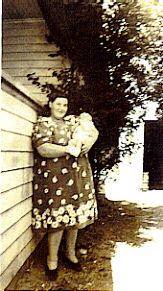
Ernest was one of the healthiest babies. At one year old, Ernest was voted the Most Beautiful Baby in San Mateo, California.
cd
Here are photos of Ernest’s father, Roy Albert Steadman, holding Ernest after he was born.
ba
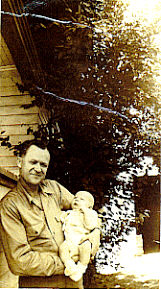 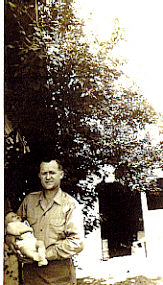
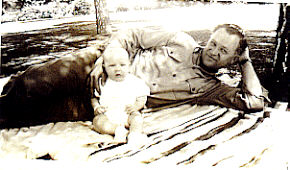
After Ernest birth, his dad began working as a maintenance man for a local Ice House, the days when people used Ice Boxes to keep their meats and vegetables in. They didn’t need electricity just a huge cube of ice put in the top of them. Ernest parents lost their next child Roy at birth in 1949.
cd
Here is Ernest wearing his dad’s hat and sitting on the porch of their home in San Mateo before the family moved some 550 miles up the coast north to Coos Bay, Oregon
ba
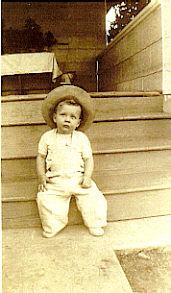
cd
Here’s a photo of Earnest and his dad standing in their back yard in Coosbay Oregon. If you look close you can see the handwriting of Ernest’s mother as she labeled the little bridge in the picture.
ba
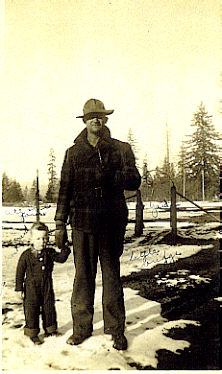
The family moved to Coosbay after the birth of his brother Roy Russell Steadman, 13 Nov 1951.
Ernest said, “You can see my Mother's writing that says "little bridge" just behind Dad. It was a walkway across the small, flowing creek behind the house. What people did, then, was place a pipe in the creek, facing upstream, and the force of the water would put water in the house at the sink. Then, you would place a pipe back into the stream, facing downstream, to dump your dirty sink water. Your closest neighbor, maybe a mile or more downstream, would do the same thing. Of course, by the time the water made its way to them, it would once again be crystal clear. And, every one had outhouses instead of indoor bathrooms.
Ernest’s dad made good money, as much as $250 to $400 a day in the early fifties cutting lumber in the woods of Oregon. Their lifestyle was relatively high middle class. The family lived well until Ernest was about 12. Robert Steadman developed bursitis in his hip and was out of work more than six months. He became very ill in 1959 and turned to drinking and gambling resulting in the loss of their home and everything they owned. The family moved from Coosbay Oregon in 1960 to Florida where his dad was from. Ernest said, “We left Oregon with the clothes on our backs and little more.”
In his own personal notes Ernest described their life in Oregon, “My Mother had this huge German Sheppard in our home for protection, not against people but against the wild life. Dad, when he came in at night, had to throw his hat into the house before entering so the dog would know who he was. Otherwise, he would have probably killed Dad. Many times, in the early morning snow, we would see fresh Cougar tracks all around the house, especially out around the outhouse. Bears were also in great abundance. The dog always went to the outhouse with Mom and me, or anytime we were outside, for protection. That was the kind of place it was.
There were five living children when the family moved from Oregon to Florida. Times were desperate, their poverty was deep. Ernest lost 30 pounds within three months of the move due to starvation. At his young age he placed his trust in God and was baptized in the Four Squares Baptist Church. Ernest went against the racial mentality of the ‘South’ and attended several Black Holiness Churches before converting to that religion. Settling on a white Holiness Church, which was very small, he soon learned first-hand the power of healing when performed by those of unquestioning faith.
cd
This photo was taken of Ernest in November of 1960. He was thirteen at the time and living in Florida.
ba
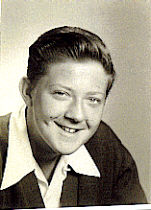
From first arriving in Florida, Ernest began going to school two days a week and working the other three days a week for local farmers, anyone needing a strong back and willing hands. The state made Ernest quit school when he was 16 and his first jobs were 13 hours a night at a local motel (7 days a week) and five days a week at a local foundry. Ernest dad was only making one dollar an hour, 36 hours a week, and traveling 13 miles to and from work, 6 days a week to do that. Two sisters were added to the family in Florida. Now with six brothers and sisters at home, Ernest being the oldest, it was just understood that he had to work and support the family. At the age of 16 with all the burdens of caring for six brothers and sisters and a partially invalid mother, Ernest would meet each day with a love for God and His greatness. The family fared better and better with each passing year. Ernest achieved his high school diploma at night school and he earned a correspondence Certificate in Applied economics and completed a College Certificate in Personal Supervision,and when Ernest was 24 he joined the United states Army.
cd
This photo was taken of Ernest when he graduated from the US Army Military Police School at Fort Gordon, Georgia in 1972
ba
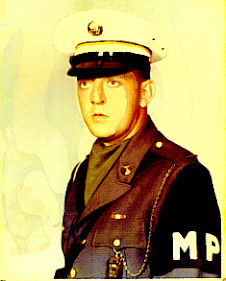
At the end of his first year of service, his mother passed away leaving the three youngest children in need of a home. Ernest had to leave the military since none of the older children were capable of or wanted to care for the younger ones and the military would not accept them as dependents for post housing unless Ernest formally adopted them. It was then in 1972 that he married his beloved Vera and together they took the responsibility of his three younger sisters and Vera’s three children, one of whom was older.
The next part of the story will pick up from here and cover the 35 years of Ernest’s life while he and Vera were together and the years following her death.
| |
